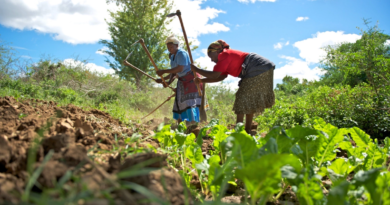Operator Reaper Thresher and Crop Residue Machinery 6 month course
Operator Reaper Thresher and Crop Residue Machinery


The Operator-Reaper Thresher and Crop Residue Machinery handles the operation of harvesting, threshing and dispatching harvesting equipment used in farming systems such as harvesting, threshing, drying, grading, etc. Brief description of work residual handling equipment such as cleaner and grader, dryer, oil expeller, etc. Your Qualifications: Operator-Reaper Thresher and Crop Residue Machinery must be operational. He or she must have a basic understanding and skills of planting. Must / must focus on the outcome and focus on his / her work and learning Operator Reaper Thresher
Carry out operation of reaper Operator Reaper Thresher:
In order to be effective, each user / individual must be able to: PC1. choose the right type of harvest, vertical harvester or self-propelled reaper based on: crop diversity crop ripening crop moisture crop condition apply the reaper by tractor / engine based on the type of PC3 harvester. check the reaper alignment with prime mover PC4. make sure all nuts and bolts are secured to PC5. ensure component compression such as PC6 for each operator. check the oil / water level on the IC engine or PC7 tractor. set the following change with the reel operator manual cutting bar binding method movement inconsistency ensure that field patterns and field adjustment are done before operation Use harvester To be competent, user / individual must be able to: PC9. turn on the first transmitter, tractor or PC10 engine. use crop harvester PC11. measure and record parameters during PC12 harvester operation. record the impact on plant diversity PC13. identify functional problems during surgery such as obstructed removal, knife cutting and transmission belts stopped, loss of PC14 power. perform the correction with the operator manual
In order to function properly, each user / individual must be able to: PC15. indicate the need for minor repairs and repairs to the PC16 harvester. check and clean PC17 guards. inspect the conveyor belt for damage and replace the PC18 if necessary. check the v-belt incompatibility on top of the PC19 roller pulley. inspect the cutting bar, knife, star wheels, pressure springs and pins for damage and take steps to repair PC20. lubricate all moving parts of PC21. repair the area where the paint has worn off

Organizational Context (Knowledge of the company / organization and its processes) Operator Reaper Thresher:
The user / person at work needs to know and understand: KA1. business code of conduct KA2. job and employment obligations KA3. procedures described by the farm machinery testing organization KA4. organizational standards and procedures for using harvesters
Technical Knowledge:
The user / person at work needs to know and understand: KB1. construction, principle of operation and operation of the cutting bar, star / wheel, head assembly assembly drive, conveyor belt assembly, power train assembly KB2. how to plan very little. Other alternatives reduce operating costs and reduce KB3 time losses. an active principle of primary transmission KB4. basic repairs and maintenance of a large KB5 carrier. standard tools for minor repairs and maintenance and their use of KB6. factors affecting the selection and placement of voting attachments KB7. Field patterns will be followed as well as field settings for KB8. rearrange such as tire adjustment, cut bar, binding and binding method, conveyor belt, etc. KB9. occurring problems with harvesters and how to fix KB10. safety precautions and precautionary measures to be taken while operating KB11 harvesters. various aspects of the Dangerous Machinery Act (Regulation), 1983

Core Skills/ Generic Skills:
The user / person at work needs to know and understand how to do this: SA1. note the details referred to SA2. be aware of farm equipment to be used in SA3. record performance limits Learning skills The user / person at work needs to know and understand how to do this: SA4. read the interpreter the required procedure
SA5. read and translate the operator manual and oral communication maintenance (listening and speaking skills) The user / person at work needs to know and understand how to do this: SA6. communication with farmers and members of the SA7 team. listen to and understand the information provided by the SA8 speaker. communication on the challenges they face. B. Practicing Professional Skills The user / employee needs to know and understand how to do this: SB1. manage issues related to equipment and equipment and decide on corrective action to be taken. edit and edit work based on instructions received by SB3. plans to use time and resources Customer Consumer The user / person at work needs to know and understand that: SB4. understand customer needs and priorities and respond according to their needs Solving Problems A user / employee needs to know and understand: SB5. ensure proper error detection and solutions by consulting with key stakeholders such as farmers and team members, experts, etc. Analytical Thinking The user / person at work needs to know and understand: SB6. use domain information about maintenance procedures and technical information on tools and equipment Key considerations The user / employee needs to know and understand: SB7. use common sense and make daily decisions
Carry out operation of thresher Operator Reaper Thresher:
To be competent, each user / individual must be familiar with PC1. select the appropriate thresher depending on the type, strength and suitability of the plant PC2. check the air indicator and enter the thresher according to the PC3 air. make sure the receiver is up to standard by fixing the pins around the PC4 wheels. mount the main slider to the frame and check the PC5 alignment. check for belt incompatibility and adjust according to PC6 manual operator. make adjustments to the speed of the threshing cylinder, concave cylinder cylinder, blower speed, air flow, slope slope and stroke length and crank speed according to the operator manual user / individual must be able to: PC7. make sure all nuts and bolts are secured to PC8. check the quality, alignment of the thresher and make sure it is suitable for PC9 belt incompatibility. check the appropriate filter size and conclave PC10. check the rotation direction of the cylinder PC11. ensure component compression such as PC12 for each operator. check the oil / water level in the IC engine or tractor Use the power supply In order to be effective, the user / individual must be able to: PC13. start the main distributor with PC14. measure the speed of the thresher using a prime mover and ensure that the desired speed is maintained by PC15. feed feed and collect clean grain after one hour of operation PC16. measure performance by divination and change the speed of the cylinder to ensure maximum efficiency of PC17. ensure the safety of each user manual during the operation of a minor repair and minor thresher operation To be competent, the user / individual must be able to: PC18. perform minor repairs and maintenance as operator PC19. wipe the stalks of grain, husks, etc. during idle PC20. performs general lubrication of moving parts to reduce aging with PC21. check and tighten all nuts and bolts
Organizational Context (Knowledge of the company / organization and its processes):
The user / person at work needs to know and understand: KA1. business code of conduct KA2. job and employment obligations KA3. standard operating procedures of the inflamed KA4. the procedures described by the organization for the testing of crushers

Technical Knowledge:
The user / person at work needs to know and understand: KB1. construction, principle of operation and operation of various types of threshing (including threshing corn, threshing of many crops etc.) KB2. various functional features of divination tools and general minor modification and KB3 retention. change of cylinder piercing speed KB4. safety precautions and precautions while using and maintaining an electric power thresher KB5. various aspects of the Dangerous Machinery Act (Regulation), 1983
Core Skills/ Generic Skills:
The user / person at work needs to know and understand how to do this: SA1. note the details referred to SA2. beware of divination / harvesting to be used in SA3. record performance limits Learning skills The user / person at work needs to know and understand how to do this: SA4. read and interpret the required procedure SA5. read and translate the operator manual and oral communication maintenance (listening and speaking skills) The user / person at work needs to know and understand how to do this: SA6. communication with farmers and members of the SA7 team. listen to and understand the information provided by the SA8 speaker. communication on the challenges they face. B. Practicing Professional Skills The user / employee needs to know and understand how to do this: SB1. manage issues related to equipment and equipment and decide on remedial action to be planned Plan and edit A user / person at work needs to know and understand how to do this: SB2. plan and focus on work based on the instructions received by SB3. plans to use time and resources Customer Consumer The user / person at work needs to know and understand that: SB4. understand customer needs and priorities and respond according to their needs
Carry out field residue management Operator Reaper Thresher:
In order to be effective, each user / individual must be able to: PC1. choose the right farm equipment to minimize the use of residues such as straw chopper, baler cutter, husk cutter, etc. PC2. check the efficiency of the equipment by performing initial PC3 checks. take corrective action if necessary PC4. put the grass in the PC5 van. choose a method of transporting grass to storage such as tractors, trailers Performs straw baler operation To be efficient, the user / individual must be able to: PC6. take the grass / hay down using the baler PC7 teeth. make sure that when the flight room is full of grass / grass, hay wraps and forms a cylinder PC8. make sure the protective cover is attached to a pile of round hay so that it does not separate during the PC9 movement. move the straw / free barley to a designated storage area To do the lawn mowing job In order to be effective, the user / individual must be able to: PC10. check chain conveyor performance, roller compression, and PC11. identify and familiarize yourself with the various sub-assemblies and materials, building materials, PC12 chopper construction. use the machine as standard operating instructions given to PC13. identify errors and take corrective action where necessary Perform work on cutters To be effective, the user / individual must be able to: PC14. select heavy-duty or high-power cutters for PC15. check the adjustment of the cutting tool such as protective equipment and machinery, tire maintenance, gap cutting, cutting length, etc.
PC16. identify common errors and take steps to fix PC17. record PC18 output quality. indicate the need for minor adjustments such as gear shifts, sharpening blades, etc. Use plant residues as needed In order to be effective, the user / individual must be able to: PC19. improve the calculation of the number of fossils produced in the various plants PC20. identify the major use of plant residues PC21. Estimate the allowable amount of crop residues that can be incorporated / stored depending on planting systems, soil, and weather conditions without creating problems for the operation of the next PC22 crop. check the quality of plant residues and their suitability for a variety of purposes

Organizational Context (Knowledge of the company / organization and its processes):
The user / person at work needs to know and understand: KA1. business code of conduct KA2. job and employment obligations KA3. organizational waste management practices for field KA4. the use identified by the organization with plant residues
Technical Knowledge:
The user / person at work needs to know and understand: KB1. parts for grass management plants and crop residues KB2. drying components such as drying room, air distribution system, direct or indirect heating system, their functions, operating conditions and materials are KB3. parts of husk cutters such as roller feeders, chute machines, wheel, cutting tools, their functions, operating principles and materials are KB6 materials. common tools for making small adjustments and maintenance of KB4. safety precautions and precautions to be taken while using and maintaining KB5. various aspects of the Dangerous Machinery Act (Regulation), 1983
Core Skills/ Generic Skills:
The user / person at work needs to know and understand how to do this: SA1. note the details referred to SA2. be aware of farm equipment to be used in SA3. record performance limits Learning skills The user / person at work needs to know and understand how to do this: SA4. read and interpret the required procedure SA5. read and translate the operator manual and oral communication maintenance (listening and speaking skills) The user / person at work needs to know and understand how to do this: SA6. communication with farmers and members of the SA7 team. listen and understand the information provided by the speaker
SA8. communication on the challenges they face. B. Practicing Professional Skills The user / employee needs to know and understand how to do this: SB1. manage issues related to equipment and equipment and decide on corrective action to be taken. edit and edit work based on instructions received by SB3. plans to use time and resources Customer Consumer The user / person at work needs to know and understand that: SB4. understand customer needs and priorities and respond according to their needs Solving Problems A user / employee needs to know and understand: SB5. ensure proper error detection and solutions by consulting with key stakeholders such as farmers and team members, experts, etc. Analytical Thinking The user / person at work needs to know and understand: SB6. use domain information about maintenance procedures and technical information on tools and equipment Key considerations The user / employee needs to know and understand: SB7. use common sense and make daily decisions
Maintain health and safety at the workplace Operator Reaper Thresher:
In order to be effective, that person must be able to: PC1. perform a basic safety test before the operation of all equipment and vehicles and report all potential hazards to the PC2 manager. identify the work for which protective clothing or equipment is required and perform those functions under the PC3 workplace policy. read and understand the risks of use and contamination mentioned on the labels of pesticides / explosives, etc. PC4. check the risk before performing manual operations, and work in accordance with current PC5 safe practices. use equipment and building materials and restore the same to designated storage where PC6 can be used. Dispose of waste again at selected PC7 location. detect hazards in viewers and take steps to reduce the risks associated with activities in the PC8 workplace. performs work in a manner that minimizes environmental damage throughout the process and ensures that hazard control task instructions are followed by PC9. report any accidents, incidents or problems without delay to the appropriate person and take the necessary immediate steps to reduce the risk.
Render appropriate emergency procedures:
In order to function properly, the person must be able to: PC10. follow. follow emergency procedures in the normal / corporate environment PC12. use emergency equipment under manufacturer specifications and PC13 service requirements. provide appropriate treatment for the patient’s injuries under the well-known first aid procedures PC14. find (if possible), clean, test / test, refresh, replace and store first aid kits as appropriate PC15. report first aid details governed by work processes
Organizational Context (Knowledge of the company / organization and its processes):
The user / person at work needs to know and understand: KA1. hygiene and fitness requirements KA2. general duties under the relevant health and safety law KA3. protective equipment to be worn and how to maintain proper and safe use of the equipment and equipment required for your work KA4. efficient and safe use of materials and equipment required for work KA5. the importance of proper housing maintenance in the work of KA6. KA7 safe waste disposal methods. ways to reduce environmental damage during work
Guidelines for Assessment:
- Criteria for assessment for each Qualification Pack will be created by the Sector Skill Council. Each Performance Criteria
(PC) will be assigned marks proportional to its importance in NOS. SSC will also lay down proportion of marks for Theory and
Skills Practical for each PC - The assessment for the theory part will be based on knowledge bank of questions created by the SSC
- Individual assessment agencies will create unique question papers for theory part for each candidate at each
examination/training center (as per assessment criteria below) - Individual assessment agencies will create unique evaluations for skill practical for every student at each
examination/training center based on this criteria - To pass the Qualification Pack , every trainee should score a minimum of 70% in aggregate
- In case of successfully passing only certain number of NOS’s, the trainee is eligible to take subsequent assessment on the
balance NOS’s to pass the Qualification Pack








